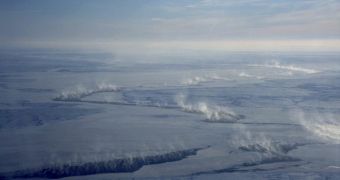In 2012, a team of researchers led by NASA investigators conducted the Bromine, Ozone, and Mercury Experiment (BROMEX) in the Arctic. Full results of the study are now in, and they highlight a process that sees more atmospheric mercury being pumped into waters close to the North Pole.
The field campaign focused on studying chemical mixing patterns that occur over Arctic sea ices that feature large cracks in their surfaces. Through these cracks, the sea water below is exposed to the atmosphere and the cold polar air, which acts like a pump for atmospheric mercury.
The main conclusion of this investigation is that it is now a lot easier for dangerous mercury compounds to make their way into the Arctic food chain than ever before. This substance first affects fish, and then all animals that consume fish, from bears and whales to sharks and humans.
During the investigation, experts analyzed mercury concentrations close to ground level in a number of leads, which are open seawater channels that appear when sea ice cracks. As climate change makes its effects felt more and more in the Arctic, more leads develop with every passing season.
Full details of the study were published in the January 15 issue of the top scientific journal Nature. The principal investigator for the BROMEX mission was Son Nghiem, who holds an appointment as a research scientist with the NASA Jet Propulsion Laboratory, in Pasadena, California.
“None of us had suspected that we would find this kind of process associated with leads,” he explained. Chris More, the lead author of the study and a scientist with the Desert Research Institute in Nevada, says that leads accumulate mercury due to the fact that they are much warmer than the air above.
This great difference in temperature levels makes the air above the water churn violently, an effect similar to what we can see in the morning above a boiling pot of water. In the Arctic, this phenomenon leads to significant chemical mixing, the team explains.
“The mixing is so strong, it actually pulls down mercury from a higher layer of the atmosphere to near the surface,” Moore explains. BROMEX experts determined that atmospheric mixing occurs up to altitudes of 400 meters (¼ miles) above sea level.
“The ‘aha’ moment came when we combined the surface measurements with the satellite data and model. We considered a bunch of chemical processes and sources to explain the increased levels of mercury we observed, until we finally realized it was this pumping process,” adds expert Daniel Obrist, a coauthor of the study, and also a researcher at the Desert Research Institute.
These conclusions again demonstrate the relevancy of the Minamata Convention, which has already been signed by 94 countries, and which deals with methods of reducing mercury concentrations in the Arctic. The document was opened for singing in October 2013.

 14 DAY TRIAL //
14 DAY TRIAL //